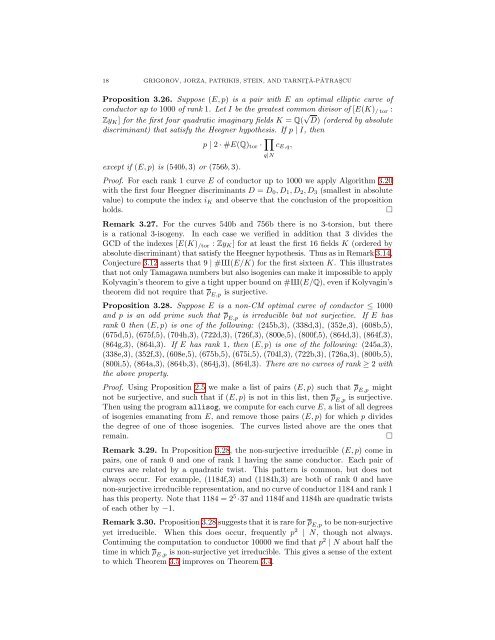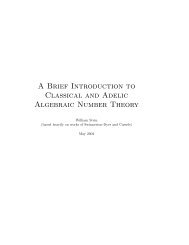COMPUTATIONAL VERIFICATION OF THE BIRCH ... - William Stein
COMPUTATIONAL VERIFICATION OF THE BIRCH ... - William Stein
COMPUTATIONAL VERIFICATION OF THE BIRCH ... - William Stein
You also want an ePaper? Increase the reach of your titles
YUMPU automatically turns print PDFs into web optimized ePapers that Google loves.
18 GRIGOROV, JORZA, PATRIKIS, STEIN, AND TARNIT¸ Ǎ-PǍTRAS¸CU<br />
Proposition 3.26. Suppose (E, p) is a pair with E an optimal elliptic curve of<br />
conductor up to 1000 of rank 1. Let I be the greatest common divisor of [E(K) / tor :<br />
ZyK] for the first four quadratic imaginary fields K = Q( √ D) (ordered by absolute<br />
discriminant) that satisfy the Heegner hypothesis. If p | I, then<br />
p | 2 · #E(Q)tor · <br />
cE,q,<br />
except if (E, p) is (540b, 3) or (756b, 3).<br />
Proof. For each rank 1 curve E of conductor up to 1000 we apply Algorithm 3.20<br />
with the first four Heegner discriminants D = D0, D1, D2, D3 (smallest in absolute<br />
value) to compute the index iK and observe that the conclusion of the proposition<br />
holds. <br />
Remark 3.27. For the curves 540b and 756b there is no 3-torsion, but there<br />
is a rational 3-isogeny. In each case we verified in addition that 3 divides the<br />
GCD of the indexes [E(K) /tor : ZyK] for at least the first 16 fields K (ordered by<br />
absolute discriminant) that satisfy the Heegner hypothesis. Thus as in Remark 3.14,<br />
Conjecture 3.12 asserts that 9 | #X(E/K) for the first sixteen K. This illustrates<br />
that not only Tamagawa numbers but also isogenies can make it impossible to apply<br />
Kolyvagin’s theorem to give a tight upper bound on #X(E/Q), even if Kolyvagin’s<br />
theorem did not require that ρ E,p is surjective.<br />
Proposition 3.28. Suppose E is a non-CM optimal curve of conductor ≤ 1000<br />
and p is an odd prime such that ρ E,p is irreducible but not surjective. If E has<br />
rank 0 then (E, p) is one of the following: (245b,3), (338d,3), (352e,3), (608b,5),<br />
(675d,5), (675f,5), (704h,3), (722d,3), (726f,3), (800e,5), (800f,5), (864d,3), (864f,3),<br />
(864g,3), (864i,3). If E has rank 1, then (E, p) is one of the following: (245a,3),<br />
(338e,3), (352f,3), (608e,5), (675b,5), (675i,5), (704l,3), (722b,3), (726a,3), (800b,5),<br />
(800i,5), (864a,3), (864b,3), (864j,3), (864l,3). There are no curves of rank ≥ 2 with<br />
the above property.<br />
Proof. Using Proposition 2.5 we make a list of pairs (E, p) such that ρ E,p might<br />
not be surjective, and such that if (E, p) is not in this list, then ρ E,p is surjective.<br />
Then using the program allisog, we compute for each curve E, a list of all degrees<br />
of isogenies emanating from E, and remove those pairs (E, p) for which p divides<br />
the degree of one of those isogenies. The curves listed above are the ones that<br />
remain. <br />
Remark 3.29. In Proposition 3.28, the non-surjective irreducible (E, p) come in<br />
pairs, one of rank 0 and one of rank 1 having the same conductor. Each pair of<br />
curves are related by a quadratic twist. This pattern is common, but does not<br />
always occur. For example, (1184f,3) and (1184h,3) are both of rank 0 and have<br />
non-surjective irreducible representation, and no curve of conductor 1184 and rank 1<br />
has this property. Note that 1184 = 2 5 ·37 and 1184f and 1184h are quadratic twists<br />
of each other by −1.<br />
Remark 3.30. Proposition 3.28 suggests that it is rare for ρ E,p to be non-surjective<br />
yet irreducible. When this does occur, frequently p 2 | N, though not always.<br />
Continuing the computation to conductor 10000 we find that p 2 | N about half the<br />
time in which ρ E,p is non-surjective yet irreducible. This gives a sense of the extent<br />
to which Theorem 3.5 improves on Theorem 3.4.<br />
q|N
















